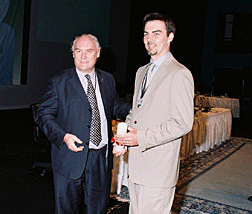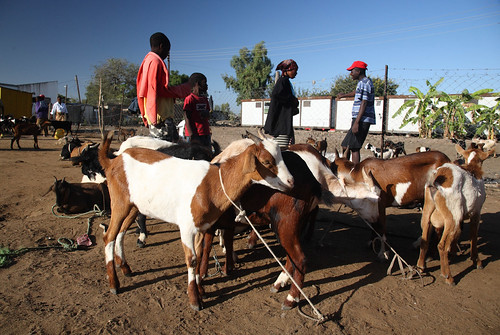Africa is now fighting bird flu literally in its backyards. Seven countries have now confirmed they have the deadly H5N1 virus in their poultry populations.
These are Nigeria, Egypt, Niger, Cameroon, Burkina Faso, Sudan and Côte d'Ivoire. Egypt has reported Africa's first cases of human infections, (13 to date) which have killed five people.
Worldwide, bird flu has hit 46 countries, killed 115 people, caused some 200 million birds to be killed at a cost of around 20 billion US dollars, and ruined the livelihoods of millions of smallholder farmers whose livelihoods depend on poultry keeping.
From 2003 to 2005 the virus was reported in 15 countries. But in the first four months of this year, it moved rapidly to 31 new countries, with major outbreaks in Turkey, Iraq, Israel, Gaza, Afghanistan, Pakistan, Myanmar and India as well as the seven African states.
The World Health Organization (WHO) is working with the United Nations Food and Agriculture Organization (FAO) and the World Organisation for Animal Health (OIE) to improve veterinary services that, in many of the affected countries, have been under-resourced for decades.
Dr David Nabarro, the UN's chief coordinator for avian influenza underscored the importance of using veterinary services to fight bird flu and the world's other emerging diseases of a communicable kind, '70 percent of which come from animals', he said.
What ILRI is doing to help its neighbours and partners fight bird flu
Like many of its partner organizations in livestock research for development, the Africa-based International Livestock Research Institute (ILRI) has been pooling its resources to contribute to the fight against this deadly disease. An internal task force is working on a number of fronts.
Several ILRI staff members sit on national avian influenza task forces set up in ILRI's hosting countries of Kenya and Ethiopia and are advising on the design of research support to control efforts in Nigeria. (Kenya's preparedness plan is considered one of the best in the developing world.) These ILRI staff are providing their veterinary and research expertise to advise on surveillance, monitoring diagnosis and control programs established to prevent or control the disease in poultry.
ILRI scientists are also preparing studies intended to generate practical information for immediate use by authorities, veterinarians and the public. These studies will compare different control strategies and assess their impacts on the poor and assist governments to prepare action plans for surveillance, control and containment of outbreaks. In longer term research, ILRI and its partners have proposed exploring the genetic make-up of chickens to unravel attributes influencing infection and transmission of the highly pathogenic form of avian influenza in various breeds.
Bird flu consultation to be held in Nairobi
In addition, ILRI and its sister Future Harvest Centre, the International Food Policy Research Institute (IFPRI), are convening a consultation of interested partners from the international research community to explore ways in which research can support efforts to control highly pathogenic avian influenza. This scientific consultation will focus on the needs of developing countries and their poor populations of poultry keepers, sellers and consumers. The meeting will be held at ILRI's Nairobi headquarters, probably in early June (dates will be confirmed shortly).
Participants at the meeting will respond to requests ILRI, IFPRI and other research institutions are receiving from donor organizations. Donors want to know how to target their bird flu research investments so as ensure that those investments support effective control of the disease while minimizing the negative impacts on the poor. ILRI is also assembling a team to undertake a rapid appraisal of past experiences in controlling bird flu. Because implementing conventional response strategies against bird flu in many developing countries can be problematical and may place particular hardship on the poor, many of whom rely on poultry for their livelihoods, this rapid research study aims to synthesize lessons learned and identify strategies that may offer more 'nuanced' means of controlling the disease while protecting the livelihoods of the poor.
Poultry maps are prepared for the battle against bird flu
Global livestock maps
In 2002, ILRI produced livestock density maps (see Mapping Poverty and Livestock in the Developing World by Thornton et al., ILRI, 2002) derived from new analyses locating major populations of poor people (including poor livestock keepers), assessing how these populations are likely to change over the next half century, and showing estimated populations of different types of livestock around the world.
African and global chicken maps
In recent weeks, using data sets provided by the Food and Agriculture Organization of the United Nations (FAO), ILRI prepared Africa and global maps of chicken densities. These maps are being used to determine areas under greatest threat and to help those countries already afflicted to target their disease control efforts.
Although the FAO-derived maps are based on the world's best information, they should be treated as indicative only; we caution against their over-interpretation (see Background Information below). This kind of macro-level analysis, while useful as a starting point, hides enormous variability, and thus can be dangerous if relied upon as a sole source of information. Ultimately, the fight against bird flu in Africa has to be conducted at much higher resolutions of basic information. (For an editorial on our lack of sufficient information, see Nature's Dreams of flu data. As the Nature editorial puts it, 'We have better data on galaxies 10 billion light years away than on human cases of avian flu in China or Vietnam.')
As ILRI agricultural systems analyst Philip Thornton, who headed ILRI's global livestock and poverty mapping project, says, 'The collation, maintenance and dissemination of baseline data is seldom supported in the agriculture sector. But in many ways, this data work is crucial to agricultural development and poverty alleviation. Information on livestock numbers and breeds in our African livestock databases is remarkably poor. Moreover, it seems clear that bird densities have to be assessed at relatively high resolution, given the heterogeneity involved.'
The maps do illustrate, however, the wide extent of 'backyard' chicken keeping in Africa—and thus the likely ubiquitous nature of any adverse impacts on the poor stemming from the appearance of bird flu or programs implemented to control it. The African and global chicken maps underscore the need to vastly upscale efforts to collect and improve our baseline information on poultry keeping. Indeed, the poverty of our information on poultry keeping in Africa is one of the biggest challenges facing agencies committed to fighting the new scourge.

Global Chicken Density
The chicken density map for Africa, below, represents a snapshot of chicken distribution for the mid- to late 1990s at sub-national level. The white areas on the map represent areas that have no reported livestock numbers available. Despite limited data, this map gives an indication of the enormous threat bird lu poses to sub-Saharan Africa.

Africa Poultry Map
Uganda poultry map
With 2002 household data from the Uganda Bureau of Statistics, ILRI produced in March 2006 high-resolution poultry maps for Uganda. The maps give important details on densities of local chickens, exotic chickens, ducks, geese and guinea fowl. Most local chickens are reared in the northeastern region and there is a high density of exotic chickens around major urban centres—Kampala, Jinja, Entebbe, Masaka, Mpigi and Mbarara—where demand has outstripped supply of local chickens. To view the Uganda maps, see ILRI's previous Top Story, Bird Maps for Uganda.

ILRI Top Story, 4 April 2006




















